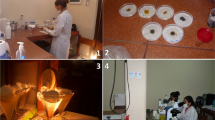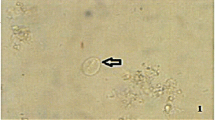Abstract
Purpose
S. stercoralis diagnosis is currently performed by parasitological methods, mainly by Baermann–Moraes (BM), although Agar Plate Culture (APC) presents a higher sensitivity. New techniques, such as TF-Test® and Coproplus® have been suggested as more practical alternatives. The aim of this study was to evaluate the sensitivity of TF-Test® and Coproplus®, compared with APC, BM and Spontaneous Sedimentation (SS) methods.
Methods
One-hundred and forty male alcoholic patients, who provided three stools samples collected on alternate days, were included in this study. The most frequently found parasite was S. stercoralis, 20% (28/140), and the most sensitive method was APC, 96.4% (27/28), followed by BM, 89.3% (25/28) and SS, 57.1% (16/28). TF-Test® and Coproplus® presented a sensitivity of 46.4 (13/28) and 39.3% (11/28), respectively. In samples with a parasitic load of 1–10 larvae/g of feces, which occurred in 39.3% (11/28) of the infected patients, both the TF-Test® and Coproplus® methods demonstrated sensitivities of 18.2% (2/11), while APC and BM methods reached a sensitivity of 100% (11/11) (p < 0.05). For other intestinal helminth infections, TF-Test® and Coproplus® sensitivities were 22.2 (4/18) and 11.1% (2/18), respectively, this being lower than the SS, 66.7% (12/18) (p < 0.05). On the other hand, for protozoa infection diagnosis, TF-Test® and Coproplus® presented the highest sensitivities, 62.2 (46/74) and 43.2% (32/74), respectively.
Conclusion
TF-Test® and Coproplus® methods presented the lowest sensitivities for S. stercoralis and other helminth infection diagnosis; therefore, they can be indicated for use in parasitological diagnosis, only when associated with other more effective methods of helminth identification.

Source: Immunoassay Ind. Com. Ltda. and NL Diagnóstica
Similar content being viewed by others
Data Availability
All data are available once requested.
Code Availability
Not applicable.
References
Greaves D, Coggle S, Pollard C, Aliyu SH, Moore EM (2013) Strongyloides stercoralis infection. BMJ 30(347):f4610. https://doi.org/10.1136/bmj.f4610
Requena-Méndez A, Chiodini P, Bisoffi Z, Buonfrate D, Gotuzzo E, Muñoz J (2013) The laboratory diagnosis and follow up of strongyloidiasis: a systematic review. PLoS Negleted Tropical Disease 7(1):e2002. https://doi.org/10.1371/journal.pntd.0002002
Khieu V, Schär F, Forrer A, Hattendorf J, Marti H, Duong S, Vounatsou P, Muth S, Odermatt P (2014) High Prevalence and Spatial Distribution of Strongyloides stercoralis in Rural Cambodia. PLoS Negl TropDis 12;8(6):e2854. https://doi.org/10.1371/journal.pntd.0002854.
Buonfrate D, Gobbi F, Beltrame A, Bisoffi Z (2016) Severe Anemia and Lung Nodule in an Immunocompetent Adopted Girl with Strongyloides stercoralis Infection. Am J Trop Med Hyg 2;95(5):1051–1053. https://doi.org/10.4269/ajtmh.16-0504.
Ngui R, Halim NA, Rajoo Y, Lim YA, Ambu S, Rajoo K et al (2016) Epidemiological characteristics of strongyloidiasis in inhabitants of indigenous communities in Borneo Island. Malaysia Korean J Parasitol 54(5):673–678. https://doi.org/10.3347/kjp.2016.54.5.673
Pacheco-Tenza MI, Ruiz-Maciá JA, Navarro-Cots M, Gregori-Colomé J, Cepeda-Rodrigo JM, Llenas-García J (2018) Strongyloides stercoralis infection in a Spanish regional hospital: Not just an imported disease. Enferm Infecc Microbiol Clin 36(1):24–28. https://doi.org/10.1016/j.eimc.2016.08.007
Guedes LV, Oliveira AIN, Guedes ALV, Soares SRC, Sipahi AM (2016) Triple infection with HTLV-1, visceral leishmaniasis and strongyloidiasis complicated by acute pancreatitis. GED gastroenterol endosc dig 35(3):96–100
Galiano A, Trelis M, Moya-Herráiz Á, Sánchez-Plumed J, Merino JF (2016) Donor-derived Strongyloides stercoralis hyperinfection syndrome after simultaneous kidney/pancreas transplantation. Int J Infect Dis 51:19–21. https://doi.org/10.1016/j.ijid.2016.08.014
- Tachamo N, Nazir S, Lohani S, Karmacharya P (2016) Strongyloidiasis in the immunocompetent: an overlooked infection. Journal Community Hosp Intern Med Perspect 7;6(4):32038. https://doi.org/10.3402/jchimp.v6.32038.
Silva MLS, Inês EJ, Souza JN, Souza ABS, Dias VMS, Oliveira LN et al (2019) Influence of parasite load on the diagnosis and occurrence of eosinophilia in alcoholic patients infected with Strongyloides stercoralis. J Helminthol 93(1):21–25. https://doi.org/10.1017/S0022149X17001110
Oliveira CL, Farias MMB, Barreto NMPV, De Souza JN, Sampaio LM, Teixeira MCA et al (2018) Intestinal parasites and socioeconomic aspects of alcoholic patients. Revista de Ciências Médicas e Biológicas 17(3):345–349. https://doi.org/10.9771/cmbio.v17i3.28665
De Souza JN, Oliveira CL, Araújo WAC, Souza ABS, Silva MLS, da Cruz IDR et al. (2020) Strongyloides stercoralis in Alcoholic Patients: Implications of Alcohol Intake in the Frequency of Infection and Parasite Load. Pathogens, 28;9(6):422. https://doi.org/10.3390/pathogens9060422.
De Souza JN, Inês Ede J, Santiago M, Teixeira MC, Soares NM (2016) Strongyloides stercoralis infection in patients with systemic lupus erythematosus: diagnosis and prevention of severe strongyloidiasis. Int J Rheum Dis 19(7):700–705. https://doi.org/10.1111/1756-185X.12644
Inês Ede J, Souza JN, Santos RC, Souza ES, Santos FL, Silva ML (2011) Efficacy of parasitological methods for the diagnosis of Strongyloides stercoralis and hookworm in faecal specimens. Acta Trop 120(3):206–210. https://doi.org/10.1016/j.actatropica.2011.08.010
Mejia R, Nutman TB (2012) Screening, prevention, and treatment for hyperinfection syndrome and disseminated infections caused by Strongyloides stercoralis. Curr Opin Infect Dis 25(4):458–463. https://doi.org/10.1097/QCO.0b013e3283551dbd
Hailegebriel T, Petros B, Endeshaw T (2017) Evaluation of parasitological methods for the detection of Strongyloides Stercoralis among individuals in selected health institutions in Addis Ababa. J Health Sci 27(5):515–522. https://doi.org/10.4314/ejhs.v27i5.10
Sato Y, Kobayashi J, Toma H, Shiroma Y (1995) Efficacy of stool examination for detection of Strongyloides infection. Am J Trop Med Hyg 53(3):248–250. https://doi.org/10.4269/ajtmh.1995.53.248
Zaha O, Hirata T, Kinjo F, Saito A (2000) Strongyloidiasis–progress in diagnosis and treatment. Intern Med 39(9):695–700. https://doi.org/10.2169/internalmedicine.39.695
Buonfrate D, Sequi M, Mejia R, Cimino RO, Krolewiecki AJ, Albonico M et al. (2015) Accuracy of five serologic tests for the follow up of Strongyloides stercoralis infection. PLoS Negl Trop. Dis 10;9(2):e0003491. https://doi.org/10.1371/journal.pntd.0003491.
Gottardi M, Paula FM, Corral MA, Meisel DM, Costa SF, Abdala E et al (2015) Immunofluorescence assay for diagnosis of strongyloidiasis in immunocompromised patients. Infect Dis (Lond) 47(8):550–554. https://doi.org/10.3109/23744235.2015.1028096
van Doorn HR, Koelewijn R, Hofwegen H, Gilis H, Wetsteyn JC, Wismans PJ et al (2007) Use of enzyme-linked immunosorbent assay and dipstick assay for detection of Strongyloides stercoralis infection in humans. J Clin Microbiol 45(2):438–442. https://doi.org/10.1128/JCM.01735-06
Buonfrate D, Formenti F, Perandin F, Bisoffi Z (2015) Novel approaches to the diagnosis of Strongyloides stercoralis infection. Clin Microbiol Infect 21(6):543–552. https://doi.org/10.1016/j.cmi.2015.04.001
Soriano-Arandes A, Sulleiro E, Zarzuela F, Ruiz E, Clavería I, Espasa M (2016) Discordances between serology and culture for Strongyloides in an Ethiopian adopted child with multiple parasitic infections: a case report. Medicine (Baltimore) 95(10):e3040. https://doi.org/10.1097/MD.0000000000003040
Buonfrate D, Requena-Mendez A, Angheben A, Cinquini M, Cruciani M, Fittipaldo A, et al. (2018) Accuracy of molecular biology techniques for the diagnosis of Strongyloides stercoralis infection-A systematic review and meta-analysis. PLoS Negl Trop Dis.;12 (2):e0006229. https://doi.org/10.1371/journal.pntd.0006229
Inês Ede J, Silva ML, Souza JN, Teixeira MC, Soares NM (2013) The role of glycosylated epitopes in the serodiagnosis of Strongyloides stercoralis infection. Diagn Microbiol Infect Dis 76(1):31–35. https://doi.org/10.1016/j.diagmicrobio.2013.01.016
Nutman TB (2017) Human infection with Strongyloides stercoralis and other related Strongyloides species. Parasitology 144(3):263–273. https://doi.org/10.1017/S0031182016000834
Carvalho JB, Santos BM, Gomes JF, Suzuki CT, Hoshino Shimizu S, Falcão AX et al (2016) TF-test modified: new diagnostic tool for human enteroparasitosis. J Clin Lab Anal 30(4):293–300. https://doi.org/10.1002/jcla.21854
Goncalves GS, Rocha RDR, Vieira BM, Garófalo GC, Costa CMS, Belém MEP et al (2016) (2016) Estudo comparativo de técnicas parasitológicas de sedimentação espontânea: kit comercial Coproplus® 10 e método de Hoffman. Pons e Janer-HPJ Revista iniciação científica 4:124–129
Arakaki T, Iwanaga M, Kinjo F, Saito A, Asato R, Ikeshiro T (1991) Efficacy of agar-plate culture in detection of Strongyloides stercoralis infection. J Parasitol 76(3):425–428. https://doi.org/10.2307/3282680
Moraes RG (1948) Contribuição para o estudo do Strongyloides stercoralis e da estrongiloidíase no Brasil. Rev Saúde Pública 1:507–624
- Hoffman WA, Pons JA, Janer JL. The sedimentation-concentration method in schistosomiasis mansonl. P R J Public Health Trop Med. 1934; 9(3).
Koga K, Kasuya S, Khamboonruang C, Sukhavat K, Ieda M, Takatsuka N, Kita K et al (1991) A modified agar plate method for detection of Strongyloides stercoralis. Am J Trop Med Hyg 45(4):518–521. https://doi.org/10.4269/ajtmh.1991.45.518
Soares FA, Benitez AN, Santos BM, Loiola SHN, Rosa SL, Nagata WB et al (2020) A historical review of the techniques of recovery of parasites for their detection in human stools. Rev Soc Bras Med Trop 53:e20190535. https://doi.org/10.1590/0037-8682-0535-2019
Gomes JF (2004) Avaliação de um novo Kit (TF-Test) nacional destinado ao diagnóstico de enteroparasitoses em amostras fecais. Instituto de Biologia, Universidade Estadual de Campinas, Dissertação
Gomes JF, Shimizu SH, Falção AX (2008) Recentes Avanços Tecnológicos no Exame Parasitológico de Amostras de Fezes. Bio Farma: Revista técnica científica de Farmácia, Bioquímica e análises clínicas e toxicológicas 3(6):44–53
Carvalho GLX, Moreira LE, Pena JL, Marinho CC, Bahia MT (2012) Machado-Coelho GLL (2012) A comparative study of the TF-Test®, Kato-Katz, Hoffman-Pons-Janer, Willis and Baermann–Moraes coprologic methods for the detection of human parasitoses. Mem Inst Oswaldo Cruz 107(1):80–84. https://doi.org/10.1590/S0074-02762012000100011
Gaburri D, Gaburri AK, Hubner E, Lopes MH, Ribeiro AM, de Paulo GA et al (1997) Intestinal parasitosis and hepatic cirrhosis. Arq Gastroenterol 34(1):7–12
Oliveira LCM, Ribeiro CT, Mendes DM, Oliveira TC, Costa-Cruz JM (2002) Frequency of Strongyloides stercoralis Infection in Alcoholics Memórias do Instituto Oswaldo Cruz Mem. Inst Oswaldo Cruz 97(1):119–121. https://doi.org/10.1590/S0074-02762002000100021
Silva ML, Inês Ede J, Souza AB, Dias VM, Guimarães CM, Menezes ER et al (2016) Association between Strongyloides stercoralis infection and cortisol secretion in alcoholics patients. Acta Trop 154:133–138. https://doi.org/10.1016/j.actatropica.2015.11.010
Teixeira MC, Pacheco FT, Souza JN, Silva ML, Inês EJ, Soares NM (2016) Strongyloides stercoralis Infection in Alcoholic Patients. Biomed Res Int 2016:4872473. https://doi.org/10.1155/2016/4872473
Acknowledgements
This work was supported with scholarships for graduate and postgraduate students and a productivity scholarship by the Fundação de Amparo à Pesquisa do Estado da Bahia (FAPESB) (Brazil), Universidade Federal da Bahia (UFBA) (Brazil), Coordenação de Aperfeiçoamento de Pessoal de Nível Superior (CAPES) (Brazil) and Conselho Nacional de Desenvolvimento Científico e Tecnológico (CNPq) (Brazil), respectively.
Funding
This work was supported by the Fundação de Amparo à Pesquisa do Estado da Bahia (FAPESB) [grant number PPSUS nª SUS0024/2018].
Author information
Authors and Affiliations
Contributions
OCL: made substantial contributions to the acquisition and interpretation of data; wrote the manuscript with support of SNM, TMCA and SJN. SN; SABS; BNMPV; RID; SLM; AWAC and SJSB contributed to the acquisition and analysis of data for the work. TMCA and SJN: aided in interpreting the results; contributed to manuscript draft and revised it critically for scientific content. SNM: designed the study and supervised the work; made substantial contributions to the interpretation of data for preparation of the manuscript and revised it critically for scientific content. All authors have approved the final version to be published.
Corresponding author
Ethics declarations
Conflicts of Interest
The authors declare that they have no conflict of interest.
Ethics Approval
This study was conducted in accordance with the Declaration of Helsinki, and the protocol was approved by the Research Ethics Committee of the Nursery School, Federal University of Bahia, Brazil, under registration number 367.464.
Consent to Participate
All subjects gave their informed consent before participating in the study.
Consent for Publication
All subjects gave their informed consent for publication of the study.
Additional information
Publisher's Note
Springer Nature remains neutral with regard to jurisdictional claims in published maps and institutional affiliations.
Rights and permissions
About this article
Cite this article
Oliveira, C.d., de Souza, J.N., Souza, A.B.d. et al. Ineffectiveness of TF-Test® and Coproplus® Methods in Strongyloides stercoralis Infection Diagnosis. Acta Parasit. 67, 732–739 (2022). https://doi.org/10.1007/s11686-021-00484-3
Received:
Accepted:
Published:
Issue Date:
DOI: https://doi.org/10.1007/s11686-021-00484-3




